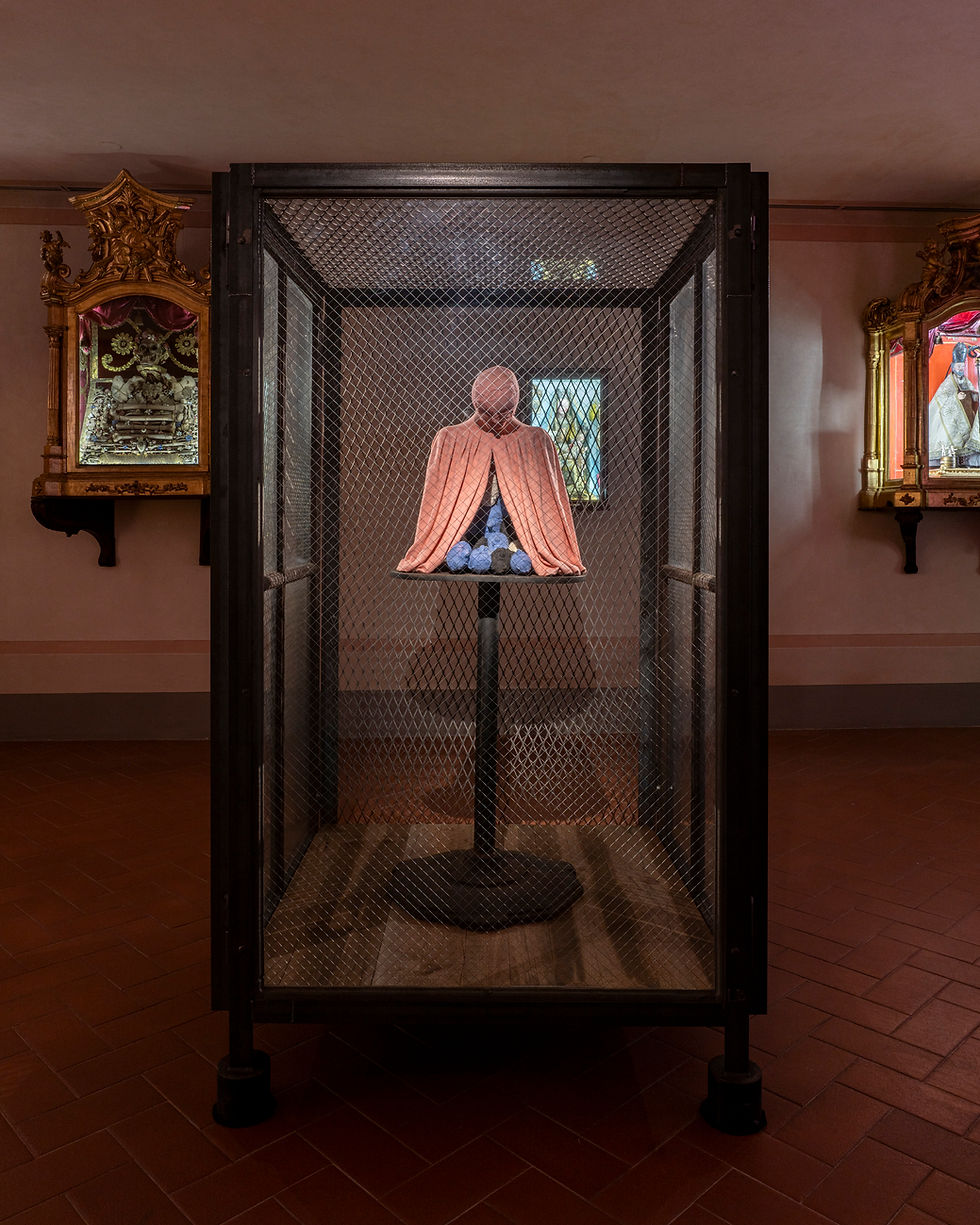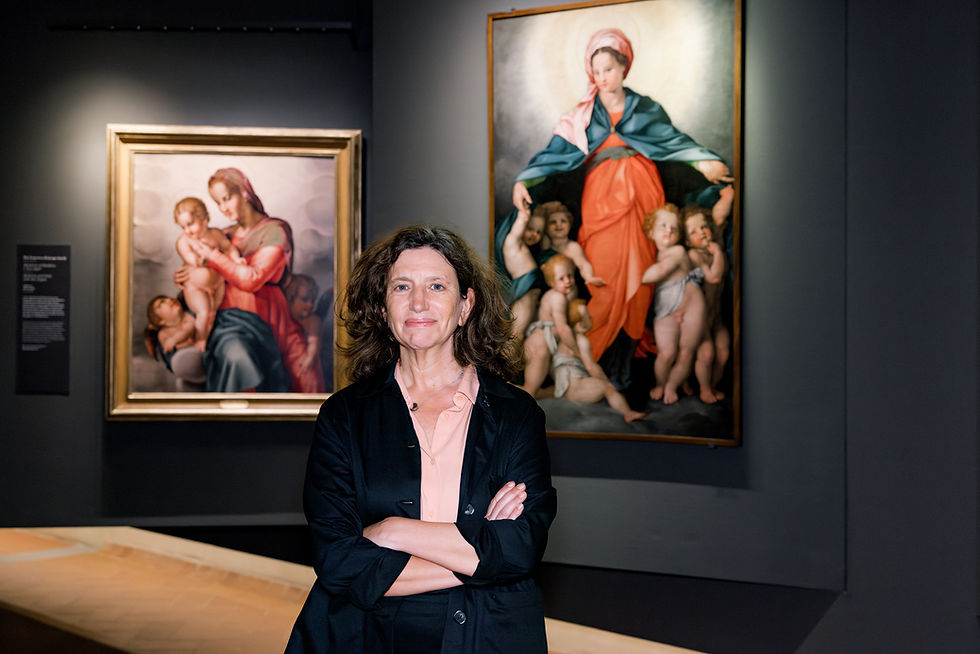LOUISE BOURGEOIS: 'CELL PORTRAIT' EXHIBITION AT THE INNOCENTI
- Staff
- Sep 26, 2024
- 5 min read
Updated: May 24
A cage and a choir
Louise Bourgeois at the Innocenti Museum
By Linda Falcone
This article was first published in Restoration Conversations
Magazine Issue 6, Autumn 2024

© Ela Bialkowska, OKNOstudio, 2025
Not long before Filippo Brunelleschi began hoisting his peppery stew up to the top of Florence’s Cathedral to feed workers building his massive dome, he won another historic commission, at ground-level, from the then-powerful Art of Silk Guild, of which he was a member. Brunelleschi was a goldsmith, not formally an architect, so his commissions were regulated by the ‘silk people’. He was to build a foundling hospital in Piazza Santissima Annunziata (1421–1428), on merchant Francesco Datini’s dime, and the children it took in were to live in a lofty and graceful place that recalled protection, not abandonment. That was how Brunelleschi came to design the first-ever example of Renaissance architecture.
Today, Brunelleschi’s hospital is home to the Innocenti Institute, Museum and Archive, which preserve its multi-century history, whilst expanding its social vocation in support of children in today’s world. Yet to fully understand the museum’s impressive collection and its recent one-work show featuring twentieth-century French-American sculptor Louise Bourgeois, we’d best go back to 1419, when the Duomo ceiling stood gaping, just a few blocks away. The cathedral, whose building started in 1296, was partially open-air during the 140 years of its construction, because no one knew how to build a dome large enough to cover it. Without the dome, not just the cathedral, but Florence itself, was incomplete.
The still unbuilt cupola, which would ultimately become the largest masonry vault ever built, was on everyone’s mind. Florentines knew the shape well from their icons of the Virgin Mary; the cupola was her cape. The ‘Madonna of Mercy’, they called her, for she sheltered humanity under the maternal arc of her silky robe. Once Brunelleschi’s hospital was ready to be filled with children – and artwork – the Madonna of Mercy icon was revisited and became the Madonna of the Innocents, as babies in swaddling clothes or toddlers wearing the Innocenti’s uniform were depicted under the Madonna’s generous mantel.
“Mary was understood as the force connecting the Earthly plane and the Divine Sphere, but she was also the figure that best represented the welcoming of children, and paintings of her are well-represented throughout the museum,” explains Arabella Natalini, the museum’s scientific curator and co-curator of the Louise Bourgeois ‘Cell Portrait’ exhibition, hosted at the Innocenti Museum, from June to October 2024, as part of the ‘Louise Bourgeois in Florence’ project, sponsored by Calliope Arts and Christian Levett Collection / FAMM, which included the show ‘Do Not Abandon Me’ at the Museo Novecento.

Co-curator Arabella Natalini with Del Conte's Madonna of the Innocents, ph. Olga Makarova
We are inside the Museum’s rafted gallery, making our way to the sculpture on show, as Dr Natalini recounts the work’s connections with the place. “As plans for the ‘Louise Bourgeois in Florence’ project developed, I initially thought we would display Cell Portrait in the gallery, in direct conversation with Jacopino Del Conte’s Madonna of the Innocents painting, because of the Bourgeois sculpture’s very clear connection with our Madonna iconography. Then it occurred to me the figure would also fit well in the choir – a room that once hosted the Innocenti’s female community. It was a place of segregation, but also of female fellowship.”
On the way to the Choir Room, we pass the orphans’ art collection, commissioned to the likes of Domenico Ghirlandaio, Sandro Botticelli and Piero di Cosimo. To create art for the foundlings, they called in the crème de la crème. “Silk Guild patrons understood the importance of art and beauty in the development of the individual, from childhood onwards,” says Natalini. “A foundling hospital had to be functional and welcoming, but also beautiful. In the Renaissance mind, the building’s structural grace needed to be matched with outstanding inside art – as food for the children’s souls.”
We can pause here, to imagine that this ‘food’ would have been especially important for the female children. The Innocenti’s male orphans were taught mathematics, music, grammar, painting and sculpture. The clergy took the boys who were best at their books, and others became members of the merchant class. Girls were often sent into service in patrician homes from 8 to 15, but all of them were taught to sew and weave. They were not educated with the boys, and were seldom taught to read or write, and never to use the abacus. Female cultural literacy was almost exclusively image-based, and through devotional art, they learned the power of story, and imagined the sacred figures worthy of their daily devotion, when they gathered in the Choir Room – to work and pray. In my mind, the orphans’ paintings were important for another reason too – they gave the girls a chance to enjoy the excesses of colour. From childhood and through their teens they wore all white. Blue frocks were allowed once they reached womanhood, but at 30, black became the only colour option available. After 36, they were transferred to the ‘hospice of Orbatello’, as old maids, where we can assume the black garb continued. Amidst the colour codes of their well-ordered quasi convent-style life, I can’t help but think they got a thrill from works like Ghirlandaio’s Adoration of the Magi, whose supernatural brightness is intoxicating even today.

© Ela Bialkowska, OKNOstudio, 2025
“Do you see?” asks Dr Natalini, once we reach the Choir Room. “The Bourgeois figure’s downward slanted gaze looks towards the head-like figures her mantal enshrines and protects. Despite being caged, she is welcoming.” To me, the ‘babies’ Bourgeois’ figure protects look like bombs waiting to go off – and I have yet to read whether that was the artist’s intent. The Choir Room is darkened, small and cavern-like, lit only by its ten display windows and tabernacles, which host small-scale devotional figures in papier-mâché and votive statues the girls created and ‘dressed’ in the miniature robes they sewed during spare time, mostly in the 1700s and 1800s. Bourgeois, the daughter of tapestry-restoring weavers would undoubtedly have appreciated their handiwork. Fabric was one of her preferred media, as Cell Portrait itself suggests.
“When mass was held in the church on via Colonna, the Innocenti’s female community ‘attended’ by peeking through the Choir Room’s long grated windows, to catch glimpses of the ritual performed by the male community down below,” Natalini explains. “They could not go in person, only in spirit.” To me, that is the sentence that settles it. Cell Portrait, a quiet caped figure who also watches the world from behind her own silent grate, is at home there.
In my mind, this one-work show is purely site specific, and its placement in the Choir Room brings me to a simple but definitive conclusion: Louise Bourgeois is one of the most talked about artists of the twentieth century. She was a person of intense, sometimes controversial artwork and worldwide success. Her public image is as far as you can get from the Innocenti’s women, who lived in monastery-like silence. Still, her soul seems in conversation with theirs somehow, and we have the artwork to prove it.
The Louise Bourgeois ‘Cell Portrait’ exhibition at the Innocenti Museum was created in conjunction with the Museo Novecento, the City of Florence and the Easton Foundation of New York, with co-curators Sergio Risaliti, Philip LaRousse, Stefania Rispoli and Arabella Natalini.
.jpg)




Comments